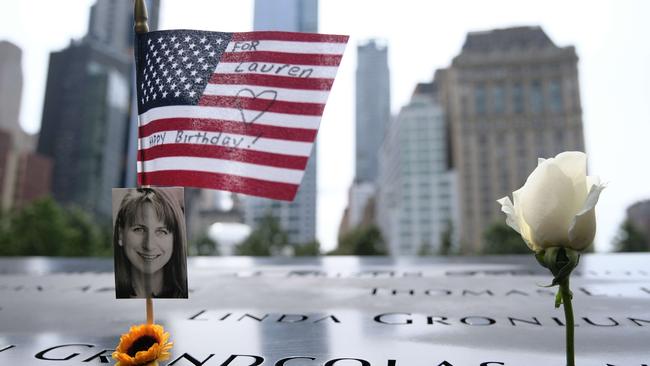War on terror holds lessons in overreach
In the 20 years since September 11, 2001, air travel security has become more intrusive, time-consuming and costly, as if the terror threat were rising, when the evidence points to the opposite.

In the 20 years since September 11, 2001, air travel security has become more intrusive, time-consuming and costly, as if the terror threat were rising, when the evidence points to the opposite.
Obviously, some prohibitions are common sense. But the removal of shoes and belts, and the placement of laptops in separate trays (sometimes), before travellers make a star shape in the big machine that goes bing reflects an obsession with airport security divorced from the reality of actual cost and risk.
For millions of travellers, bloated airport security is the most visible legacy of the horrific attacks on New York’s World Trade Centre, a reminder how emotion governs our behaviour at least as much as our rational faculties. Air travel was relatively safe before September 11, 2001, and remains relatively safe after it. People are far more likely to be struck by lightning – roughly one in a million – than killed in a terrorist attack, regardless of how much their government spends on counter-terrorism.
In Europe, the US and Australia, the chances of being killed in a terror attack are one in nine million, 19 million and 80 million, respectively, according to Mark Stewart, an engineer and risk analyst at the University of Newcastle whose book Are We Safe Enough? questions the value for money in airport security.
The US has spent more than $US2 trillion since 2001 on counter-terrorism efforts, creating a new government department, Homeland Security; Australia has spent about $30bn, he estimates.
“For the costs of the American counter-terrorism enterprise to begin to be justified, they would need to have deterred or disrupted a wildly unlikely number of terrorist attacks that would have occurred in their absence,” he tells The Australian, suggesting they would need to have averted about three 9/11 attacks every four years, or 30 London Tube bombings, which killed 52 people in 2005, every year, given what governments typically spend to save lives. “A person would need to fly once per day for 30,000 years before being involved in a terrorist attack,” he says.
It’s even possible the wars launched by the US in Afghanistan, Syria and Iraq since 2001, broadly as a response to the public’s new-found fear of Islamic states, have killed vastly more people than they could have possibly saved from terror attacks.
Brown University in the US calculates that 929,000 people have died as a result in these wars, which also created 38 million refugees and cost the US government more than $US8 trillion.
The wars even may have increased the threat: the Boston marathon bombing in 2013, which killed three people and injured dozens, was a reprisal for the US invasion of Iraq and Afghanistan. All the extra US spending on counter-terrorism at home and military action abroad hasn’t even calmed our nerves. In 2016, after 15 years of the Patriot Act, a 2001 US law that expanded the surveillance powers of the federal government, 71 per cent of Americans said the risk of a terrorist attack on the US by foreigners was greater (40 per cent) or the same, according to the Pew Research Centre.
“The constant unnuanced stoking of fear by politicians, bureaucrats, experts and the media, however well received by the public, is on balance costly, enervating, potentially counter-productive and unjustified by the facts,” Stewart says.
US intelligence’s assessment of the Afghan army and government proved hopelessly wrong last month. Similarly, fears in 2001 that 9/11-style attacks would become more common failed to materialise. It’s possible the world is not as scary as the government and businesses that profit from fear want you to think it is. “Less than one alarm in 10,000 fails to be false … and the vast majority of the leads deemed to be productive have led to terrorist enterprises that are either trivial or at most aspirational,” Stewart writes in his 2016 book, Chasing Ghosts.
Our reaction to 9/11 leaves powerful lessons for our ongoing response to Covid-19, which has claimed the mantle of biggest over-reaction in history. First, people are terrible with numbers, unable to put deaths or risks in context. The images of burning skyscrapers and crashing planes, or suffocating Covid-19 patients on ventilators, fuel a highly exaggerated sense of personal risk.
Second, fear leads to over-reaction by government, which is never unwound. Indeed, during the pandemic the risk from a terrorist attack on aeroplanes obviously declined because it was so much harder to travel, yet airport security didn’t change.
No government has sought to estimate the actual terrorism risk from flying, let alone whether the expenditures and prohibitions pass a cost benefit, because the answer would raise awkward questions for the security-industrial complex that profits handsomely from these arrangements.
Third, what economists call the sunk-cost fallacy is endemic. If the facts no longer support wars, or locking down cities for that matter, change course. Previous costs, no matter how large or emotionally troubling, shouldn’t guide what’s best to do now.
George Orwell wrote, “The war is not meant to be won, it is meant to be continuous.” Wars on terror or viruses are perfect candidates for never-ending wars. If we don’t heed these lessons, 20 years from now we’ll still have our nail scissors and Rexona confiscated before we take a mandatory Covid test, double-masked, on our way to a quarantine facility for two weeks. God help us if there’s another crisis on the horizon.




A flight to Los Angeles became a lot safer recently after my nail scissors were confiscated at airport security. Imagine what someone could do with nail scissors or a can of aerosol deodorant on a plane, as opposed to on a bus or train, for instance, where you can still carry such lethal weapons.